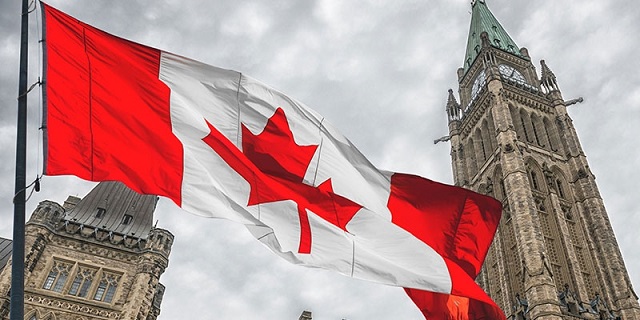Economy
Housing policy should focus on closing the demand-supply gap, not inducing demand or stifling supply

From the Fraser Institute
FEDERAL REFORMS TO IMPROVE HOUSING AFFORDABILITY
BY JOSEF FILIPOWICZ AND STEVE LAFLEUR
Canada’s declining housing affordability reflects a large, worsening imbalance between housing demand and housing supply.
Few policy areas are gaining as much attention in Canada as housing. This is unsurprising, given that Canada has the largest gap between homes prices and incomes among G7 nations (OECD, 2023) and rents continue to rise in most cities (Statistics Canada, 2023a). As eroding housing affordability has expanded to more parts of Canada, demands for policy solutions have grown beyond local jurisdictions, pressuring federal decisionmakers to act.
First, this essay offers a diagnosis of the issue—a large, growing imbalance between housing demand and supply. Second, it discusses federal policies affecting housing demand, urging better coordination and restraint amid tight supply conditions. Third, it discusses the federal government’s less-direct—though still important—options to improve housing supply.
Guiding principles: do no more harm, and close the demand-supply gap
Canada’s declining housing affordability reflects a large, worsening imbalance between housing demand and housing supply. This is evident when comparing trends in population growth and housing completions. Figure 1 charts these two metrics between 1972 and 2022. In recent years, Canada’s population growth has accelerated, while the number of homes completed has declined relative to the 1970s. 1

Policy efforts should focus on closing the demand-supply gap. The federal government should first ensure that it is not exacerbating the problem, either by stoking demand or by stifling supply, and second by both reviewing all existing policies through a supply-demand lens while implementing tailored policies aimed at closing the demand-supply gap.
Demand-side considerations for federal housing policy
Though all levels of government influence both housing demand and supply, the federal government’s policy levers pertain more directly to demand. They do so in two important ways.
First, federal policy influences population growth. As Canada’s birth rate has declined, population growth has been driven primarily by immigration (including both permanent and temporary residents) (Statistics Canada, 2023c). Though provinces may influence immigration decisions, the federal government establishes annual targets (where applicable) and admission criteria (Filipowicz and Lafleur, 2023).
Second, the federal government influences households’ ability to pay for housing. Policies for home buyers including the First-Time Home Buyers’ Tax Credit and the First Home Savings Account, which, combined with the Home Buyers’ Plan, enable the accumulation of tax-free savings for a down payment. 2 Federal policies for homeowners include the exemption from capital gains taxation on the sale of primary residences, loan insurance through the Canada Mortgage and Housing Corporation, and residential mortgage underwriting through the Office of the Superintendent of Financial Institutions. Combined, these policies influence the relative attractiveness of housing as an investment.
Without adequate supply, these policies result in higher prices, rather than greater affordability. The federal government should review all existing or proposed policies directly or indirectly impacting housing demand. Further, it should adopt the following two policy approaches:
• Stronger consideration of housing supply dynamics when determining short, medium and long-term immigration targets or visa issuance. For example, supply metrics (e.g. housing starts, completions, and rental vacancy rates) should help inform multi-year plans or criteria for permanent and non-permanent resident admissions.
• Refraining from introducing new demand-inducing subsidies, such as tax credits or subsidies to homebuyers and homeowners, while comprehensively reviewing the impact of existing subsidies.
Supply-side considerations for federal housing policy
Housing supply in Canada is influenced primarily by provincial and local governments. Decisions concerning land-use and growth planning—including for lands owned by the federal government—largely rest with these levels of government, meaning housing construction projects cannot be realized without first aligning with, and receiving approval from, local authorities. Federal policies aiming to grow the housing supply must account for this.
Federal influence on housing supply can be divided into four policy types. First are fiscal transfers. Every year the federal government transfers billions of dollars to municipalities to fund infrastructure. In some cases, funding is permanent and based on federal-provincial agreements.3 In other cases, funding is negotiated for specific projects.4
Second, the federal government also funds the development of non-market housing. Programs such as the National Co-Investment Fund and Rapid Housing Initiative offer low-interest or forgivable loans, and direct funding, respectively, to organizations building or acquiring non-market housing.
Third, federal tax policies and programs influence the financial feasibility of homebuilding. For example, federal sales and capital gains taxes apply differently to different housing types, such as condominiums, rental buildings and accessory dwelling units (e.g. basement or laneway suites).5
Further, federal programs such as the Rental Construction Financing Initiative and multi-unit mortgage loan insurance products influence project feasibility by providing rental builders with low-interest loans or reduced premiums.
Fourth, the federal government’s primary responsibility for immigration gives it significant influence over the mix of skills prioritized in application screening, affecting the construction sector’s ability to recruit workers. Indeed, the share of immigrants working in the construction sector was lower than that among Canada’s overall population in 2020 (BuildForce Canada, 2020), reflecting the longstanding selection preferences of federal immigration policy until more recent changes.6
The federal government should coordinate with local and provincial governments as it develops policies, avoiding the creation of additional barriers and duplication. Specifically, the following three approaches should inform federal efforts to improve housing supply:
• Tying all federal infrastructure funding to housing supply metrics such as housing stock growth, starts or completions, ensuring limited funds are directed to those regions facing the strongest growth pressures in a transparent fashion, while reducing administrative costs and jurisdictional overlap.
• Reviewing and reforming the tax treatment of all housing development, helping improve the feasibility of large- and small-scale projects Canada-wide.
• Further prioritizing skills related to homebuilding in immigration policies and eligibility criteria.
Conclusion
Faced with a widening gap between housing demand and supply, this essay focuses on the federal government’s influence on housing markets, offering five areas of policy action.
The most direct federal levers pertain to housing demand. Housing constraints should be weighed more heavily when setting immigration policy, including temporary immigration, and new demand-inducing policies such as homebuyer tax credits should be avoided, while existing policies should be reviewed.
Given the federal government’s less direct influence on housing supply, intergovernmental coordination is recommended. Limited transfer funding should follow local housing supply metrics, while the tax treatment of housing development could also be reformed, enabling a larger number of projects to be financially feasible. Lastly, immigration policies should emphasize skills required to build more housing.
Authors:
1 For more on the gap between population growth and housing completions, see Filipowicz (2023).
2 For a full list of incentives and rebates for homebuyers, see <https://www.cmhc-schl.gc.ca/consumers/home-buying/government-of-canada-programs-to-support-homebuyers>, as of February 5, 2023.
3 For example, the Canada Community-Building Fund (formerly the Gas Tax Fund) delivers approximately $2 billion annually to local governments.
It is governed by a series of federal-provincial agreements.
4 For example, the federal government has committed one-third of the capital funding required by the Surrey Langley SkyTrain. Similar agreements
are common for major transit infrastructure.
5 The federal government recently announced the removal of the goods and services tax on purpose-built rental housing, helping the feasibility
of this housing class. For more on the influence of federal taxation on rental housing, see Canadian Home Builders’ Association (2016).
6 Immigration, Refugees and Citizenship Canada changed screening processes in mid-2023, favouring trade occupations, among others. The full effects of these changes will become apparent with time.
Canadian Home Builders’ Association (2016). Encouraging Construction and Retention of Purpose-Built Rental Housing in Canada: Analysis of Federal Tax Policy Options. <https://www.evergreen.ca/downloads/pdfs/HousingActionLab/HAL_EncouragingConstructionAndRetention_FINAL.pdf> as of September 13, 2023.
Filipowicz (2023). Canada’s Growing Housing Gap: Comparing Population Growth and Housing Completions in Canada, 1972–2022.
Fraser Institute. <https://www.fraserinstitute.org/sites/default/files/canadas-growing-housing-gap-1972-2022.pdf>, as of February
5, 2024.
Filipowicz, Josef and Steve Lafleur (2023a). Getting Our Houses in Order: How a Lack of Intergovernmental Policy Coordination
Undermines Housing Affordability in Canada. Macdonald-Laurier Institute. <https://macdonaldlaurier.ca/getting-our-houses-in-order-how-a-lack-of-intergovernmental-policy-coordination-undermines-housing-affordability-in-canada/>, as of February 5, 2024.
Immigration, Refugees and Citizenship Canada (2023). Express Entry Rounds of Invitations: Category-based Selection. <https://www.
canada.ca/en/immigration-refugees-citizenship/services/immigrate-canada/express-entry/submit-profile/rounds-invitations/category-based-selection.html>, as of September 15, 2023.
International Monetary Fund (2023). Report for the 2023 Article IV Consultation. [or Country Report: Canada]. <https://www.imf.
org/en/Publications/CR/Issues/2023/07/27/Canada-2023-Article-IV-Consultation-Press-Release-and-Staff-Report-537072> as of
September 13, 2023.
Organisation for Economic Cooperation and Development [OECD]. 2023. Housing Prices (indicator). DOI: 10.1787/63008438.
OECD. <https://data.oecd.org/price/housing-prices.htm>, as of February 5, 2023.
Statistics Canada (2023a). Table 34-10-0133-01. Canada Mortgage and Housing Corporation, average rents for areas with a population of 10,000 and over. <https://www150.statcan.gc.ca/t1/tbl1/en/cv.action?pid=3410013301>, as of February 5, 2023.
Statistics Canada (2023b). Table 34-10-0127-01. Canada Mortgage and Housing Corporation, vacancy rates, apartment structures of six units and over, privately initiated in census metropolitan areas. <https://www150.statcan.gc.ca/t1/tbl1/en/tv.action?pid=3410012701>, as of February 5, 2024.
Statistics Canada (2023c). Table 17-10-0008-01. Estimates of the components of demographic growth, annual. <https://www150.
statcan.gc.ca/t1/tbl1/en/tv.action?pid=1710000801>, as of March 2, 2023.
Business
Economic progress stalling for Canada and other G7 countries

From the Fraser Institute
By Jake Fuss
For decades, Canada and other countries in the G7 have been known as the economic powerhouses of the world. They generally have had the biggest economies and the most prosperous countries. But in recent years, poor government policy across the G7 has contributed to slowing economic growth and near-stagnant living standards.
Simply put, the Group of Seven countries—Canada, France, Germany, Italy, Japan, the United Kingdom and the United States—have become complacent. Rather than build off past economic success by employing small governments that are limited and efficient, these countries have largely pursued policies that increase or maintain high taxes on families and businesses, increase regulation and grow government spending.
Canada is a prime example. As multiple levels of government have turned on the spending taps to expand programs or implement new ones, the size of total government has surged ever higher. Unsurprisingly, Canada’s general government spending as a share of GDP has risen from 39.3 per cent in 2007 to 42.2 per cent in 2022.
At the same time, federal and provincial governments have increased taxes on professionals, businessowners and entrepreneurs to the point where the country’s top combined marginal tax rate is now the fifth-highest among OECD countries. New regulations such as Bill C-69, which instituted a complex and burdensome assessment process for major infrastructure projects and Bill C-48, which prohibits producers from shipping oil or natural gas from British Columbia’s northern coast, have also made it difficult to conduct business.
The results of poor government policy in Canada and other G7 countries have not been pretty.
Productivity, which is typically defined as economic output per hour of work, is a crucial determinant of overall economic growth and living standards in a country. Over the most recent 10-year period of available data (2013 to 2022), productivity growth has been meagre at best. Annual productivity growth equaled 0.9 per cent for the G7 on average over this period, which means the average rate of growth during the two previous decades (1.6 per cent) has essentially been chopped in half. For some countries such as Canada, productivity has grown even slower than the paltry G7 average.
Since productivity has grown at a snail’s pace, citizens are now experiencing stalled improvement in living standards. Gross domestic product (GDP) per person, a common indicator of living standards, grew annually (inflation-adjusted) by an anemic 0.7 per cent in Canada from 2013 to 2022 and only slightly better across the G7 at 1.3 per cent. This should raise alarm bells for policymakers.
A skeptic might suggest this is merely a global phenomenon. But other countries have fared much better. Two European countries, Ireland and Estonia, have seen a far more significant improvement than G7 countries in both productivity and per-person GDP.
From 2013 to 2022, Estonia’s annual productivity has grown more than twice as fast (1.9 per cent) as the G7 countries (0.9 per cent). Productivity in Ireland has grown at a rapid annual pace of 5.9 per cent, more than six times faster than the G7.
A similar story occurs when examining improvements in living standards. Estonians enjoyed average per-person GDP growth of 2.8 per cent from 2013 to 2022—more than double the G7. Meanwhile, Ireland’s per-person GDP has surged by 7.9 per cent annually over the 10-year period. To put this in perspective, living standards for the Irish grew 10 times faster than for Canadians.
But this should come as no surprise. Governments in Ireland and Estonia are smaller than the G7 average and impose lower taxes on individuals and businesses. In 2019, general government spending as a percentage of GDP averaged 44.0 per cent for G7 countries. Spending for governments in both Estonia and Ireland were well below this benchmark.
Moreover, the business tax rate averaged 27.2 per cent for G7 countries in 2023 compared to lower rates in Ireland (12.5 per cent) and Estonia (20.0 per cent). For personal income taxes, Estonia’s top marginal tax rate (20.0 per cent) is significantly below the G7 average of 49.7 per cent. Ireland’s top marginal tax rate is below the G7 average as well.
Economic progress has largely stalled for Canada and other G7 countries. The status quo of government policy is simply untenable.
Author:
Economy
‘Gambling With The Grid’: New Data Highlights Achilles’ Heel Of One Of Biden’s Favorite Green Power Sources

 From the Daily Caller News Foundation
From the Daily Caller News Foundation
By NICK POPE
New government data shows that wind power generation fell in 2023 despite the addition of new capacity, a fact that energy sector experts told the Daily Caller News Foundation demonstrates its inherent flaw.
Wind generation fell by about 2.1% in 2023 relative to 2022 generation, despite the 6 gigawatts (GW) of wind power capacity that came online last year, according to data published Tuesday by the U.S. Energy Information Administration (EIA). That wind power output dropped despite new capacity coming online and the availability of government subsidies highlights its intermittency and the problems wind power could pose for grid reliability, energy sector experts told the DCNF.
The decrease in wind generation is the first drop on record with the EIA since the 1990s; the drop was not evenly distributed across all regions of the U.S., and slower wind speeds last year also contributed to the decline, according to EIA. The Biden administration wants to have the American power sector reach carbon neutrality by 2035, a goal that will require a significant shift away from natural gas- and coal-fired power toward wind, solar and other green sources.

A table depicting the decrease of wind power generation in 2023 relative to 2022. (Screenshot via U.S. Energy Information Administration)
“Relying on wind power to meet your peak electricity demands is gambling with the grid,” Isaac Orr, a policy fellow at the Center of the American Experiment who specializes in power grid-related analysis, told the DCNF. “Will the wind blow, or won’t it? This should be a moment where policymakers step back and consider the wisdom of heavily subsidizing intermittent generators and punishing reliable coal and gas plants with onerous regulations.”
Between 2016 and 2022, the wind industry received an estimated $18.6 billion worth of subsidies, about 10% of the total amount of subsidies extended to the energy sector by the U.S. government, according to an August 2023 EIA report. Wind power received more assistance from the government than nuclear power, coal or natural gas over the same period of time.
“This isn’t subsidies per kilowatt hour of generation. It’s raw subsidies. If it were per kilowatt hour of generation, the numbers would be even more extreme,” Paige Lambermont, a research fellow at the Competitive Enterprise Institute, told the DCNF. “This is a massive amount of money. It’s enough to dramatically alter energy investment decisions for the worse. We’re much more heavily subsidizing the sources that don’t provide a significant portion of our electricity than those that do.”
“Policy that just focuses on installed capacity, rather than the reliability of that capacity, fails to understand the real needs of the electrical grid,” Lambermont added. “This recent disparity illustra
Wind power’s performance was especially lackluster in the upper midwest, but Texas saw more wind generation in 2023 than it did in 2022, according to EIA. Wind generation in the first half of 2023 was about 14% lower than it was through the first six months of 2022, but generation was higher toward the end of 2023 than it was during the same period in 2022.
In 2023, about 60% of all electricity generated in the U.S. came from fossil fuels, while 10% came from wind power, according to EIA data. Beyond generous subsidies for preferred green energy sources, the Biden administration has also aggressively regulated fossil fuels and American power plants to advance its broad climate agenda.
Biden’s Climate Bill Boosted An Offshore Wind Giant, But His Economy Brought It To The Brink https://t.co/AF7SPT2FNu
— Daily Caller (@DailyCaller) November 3, 2023
The Environmental Protection Agency’s (EPA) landmark power plant rules finalized this month will threaten grid reliability if enacted, partially because the regulations are likely to incentivize operators to close plants rather than adopt the costly measures required for compliance, grid experts previously told the DCNF. At the same time that the Biden administration is effectively trying to shift power generation away from fossil fuels, it is also pursuing goals — such as substantially boosting electric vehicle adoption over the next decade and incentivizing construction of energy-intensive computer chip factories — that are driving up projected electricity demand in the future.
“The EIA data proves what we’ve always known about wind power: It is intermittent, unpredictable and unreliable,” David Blackmon, a 40-year veteran of the oil and gas industry who now writes and consults on the energy sector, told the DCNF. “Any power generation source whose output is wholly dependent on equally unpredictable weather conditions should never be presented by power companies and grid managers as safe replacements for abundant, cheap, dispatchable generation fueled with natural gas, coal or nuclear. This is a simple reality that people in charge of our power grids too often forget. Saying that no doubt hurts some people’s feelings, but nature really does not care about our feelings.”
Blackmon also pointed out that, aside from its intermittency, sluggish build-out of the transmission lines and related infrastructure poses a major problem for wind power.
“Wind power is worthless without accompanying transmission, yet the Biden administration continues to pour billions into unreliable wind while ignoring the growing crisis in the transmission sector,” Blackmon told the DCNF.
Another long-term issue that wind power, as well as solar power, faces is the need for a massive expansion in the amount of battery storage available to store and dispatch energy from intermittent sources as market conditions dictate. By some estimates, the U.S. will need about 85 times as much battery storage by 2050 relative to November 2023 in order to fully decarbonize the power grid, according to Alsym Energy, a battery company.
The White House and the Department of Energy did not respond to requests for comment.
-

 COVID-192 days ago
COVID-192 days agoKenyan doctor: WHO pandemic treaty aims to ‘maim and kill’ and ‘establish a one-world government’
-

 Brownstone Institute17 hours ago
Brownstone Institute17 hours agoMedical Elites’ Disgrace Over Ivermectin
-

 conflict9 hours ago
conflict9 hours ago‘It Makes No Sense’: Experts Puzzled By Biden Admin’s Claim That Rafah Invasion Wouldn’t Help Israel Defeat Hamas
-

 Automotive2 days ago
Automotive2 days agoElectric vehicle mandates mean misery all around
-

 Bruce Dowbiggin1 day ago
Bruce Dowbiggin1 day agoGetting Real About Justin’s Real Estate Economy. It Won’t Last
-

 Opinion17 hours ago
Opinion17 hours agoThe American Experiment Has Gone Down In Flames
-

 Energy5 hours ago
Energy5 hours agoBuckle Up for Summer Blackouts: Wind Is Already Failing Texas in Spring
-

 Bruce Dowbiggin6 hours ago
Bruce Dowbiggin6 hours agoWhy Do The Same Few Always Get The Best Sports Scoops?










